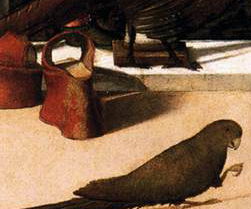Right, where were we? Oh yes, the implicit sexuality of not being able to walk properly in pianelle.

Chopines, 1580-1620. [image source]
The Bata Shoe Museum tells us that Venetian chopines (an especially tall type of pianelle) typically ranged from five to nine inches (so the alarming 20-inch pair we saw in part one weren’t the norm). High pianelle gave women a sensual gait, or as Castiglione described it, a “grandissima gratia” (“very high grace”) to the posture and walk. The motion of Renaissance women’s walk was of particular significance as the leg itself was hidden underneath long skirts. Courtesans chose pianelle specifically for this relationship between restricted movement and eroticism, and used them as “a tool to identify their sexual availability and social position.” [i] But how high was too high?

Two Venetian Ladies, Vittore Carpaccio, 1490. [image source]
Pianelle reveal great subtlety in the language of Renaissance dress. The gradations in meaning were such that “a few inches’ difference in the thickness of soles seems to have originally revealed the distinction between the famous and the infamous, and between appropriate and inappropriate behavior of the sixteenth century.” [ii] An example of the misreading of pianelle within the social context of the Renaissance comes from the 1490 Vittore Carpaccio painting Two Ladies: the two women depicted were originally misinterpreted by nineteenth century male scholars, such as John Ruskin, as absurdly vain or otherwise sexually immoral women due to the height of the red chopines seen in the corner. However,
testimonies indicate that in the 1490s, the comparatively low handbreadth-tall
chopines painted by Carpaccio may well have been perceived as a sign of good
taste and moderation, rather than as a symbol of licentious behavior. The ‘female
pride’ that Ruskin read in the wearing of the chopines seems in fact to have been
very much the opposite: a compliment by Carpaccio to his sitters’ virtues and
fashionable moderation. [iii]
Okay, let’s re-cap. Pianelle – chopines in particular – were expensive, impractical, fancy shoes for the wealthy, upper-class Venetian ladies. And the reasonable height of a “handbreadth” (looks about 5 inches to me) meant you had good taste. But courtesans wore them too.
![Courtesan and Blind Cupid, Pietro Bertelli, 1588. [image source]](https://mycostumehistory.files.wordpress.com/2014/01/courtesan-and-blind-cupid.jpg?w=640)
Courtesan and Blind Cupid, Pietro Bertelli, 1588. [image source]
So how to be sure if the woman in the chopines was a wealthy patrician or a prostitute drumming up business? According to the Metropolitan Museum of Art, you couldn’t: “the elaborate dress of the respectable Venetian noblewoman was almost indistinguishable from the costume of the successful courtesan. So vexing was the confusion that sumptuary restrictions were established to define the boundary and at one point prohibited courtesans from wearing silk dresses and virtually all jewelry.”
I suppose the confusion puts those laws from part one into context – something that I missed completely when I first wrote this paper four years ago. Now it’s even MORE fascinating!
In any event, pianelle have persisted throughout the years and are here to stay. Thanks to Fashionista.com for providing an apt concluding image!
![Venetian Chopines and Jeffrey Campbell [image source]](https://mycostumehistory.files.wordpress.com/2014/01/chopines-and-jeffrey-campell-heels-copy-640x384.jpg?w=640&h=384)
Venetian Chopines and Jeffrey Campbell. [image source]
Sources
[i] Maria Guiseppina Muzzarelli, “Sumptuous Shoes,” in Shoes, a History from Sneakers to Sandals, eds. Giorgio Riello and Peter McNeil (Oxford: Berg Publishers, 2006), 65.
[ii] Andrea Vianello, “Courtly Lady or Courtesan?” in Shoes, a History from Sneakers to Sandals, eds. Giorgio Riello and Peter McNeil (Oxford: Berg Publishers, 2006), 77.
[iii] Vianello, 83-84.
